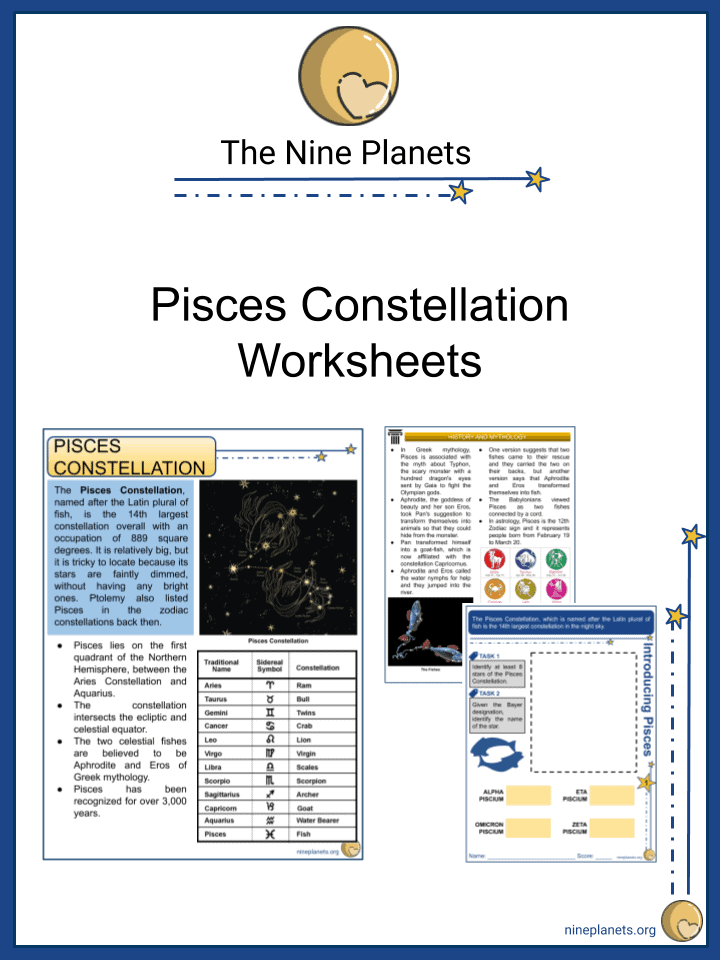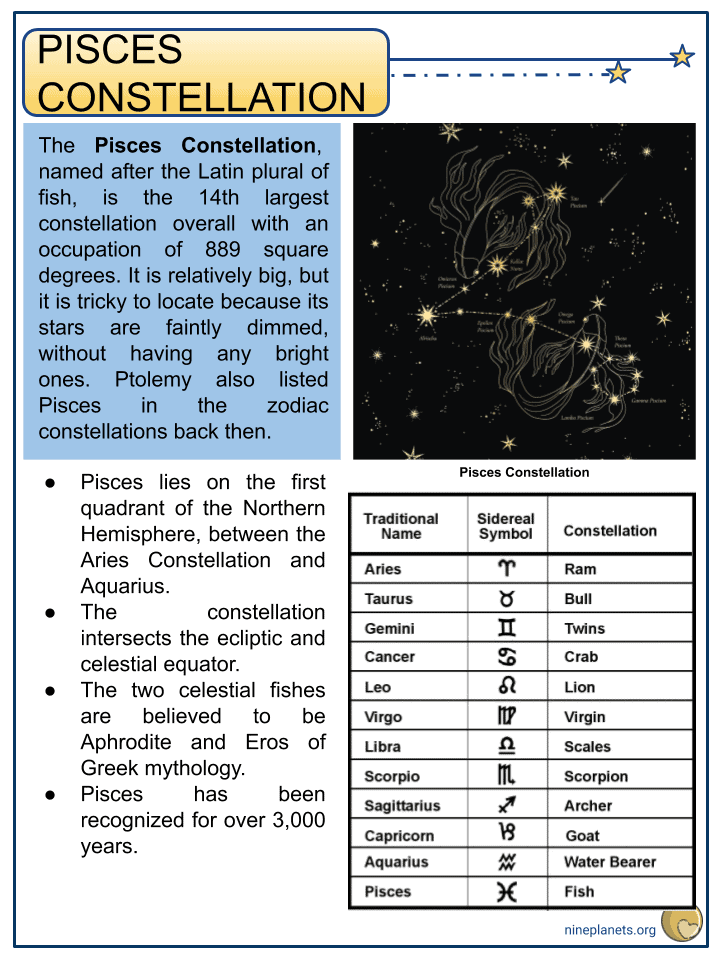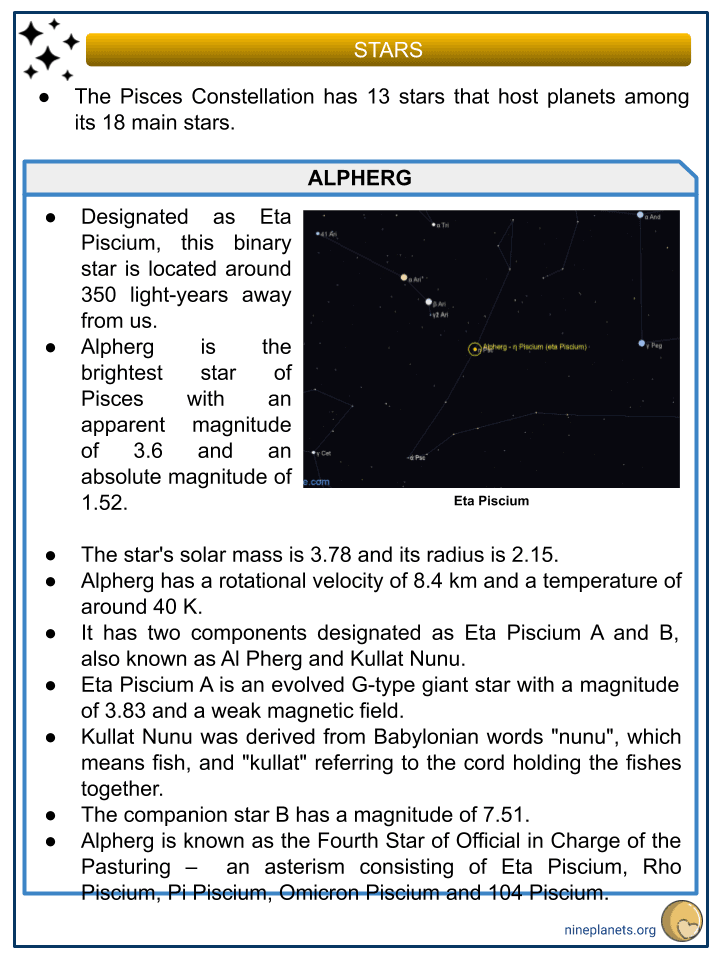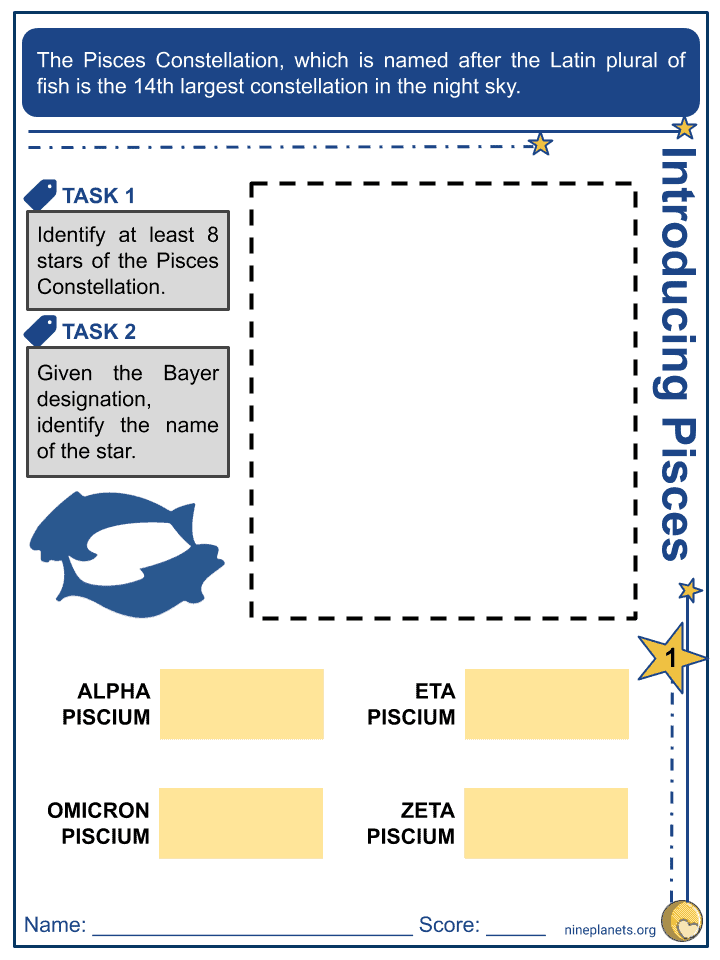Download Pisces Constellation Worksheets
Click the button below to get instant access to these premium worksheets for use in the classroom or at a home.

This worksheet can be edited by Premium members using the free Google Slides online software. Click the Edit button above to get started.
Download free sample
Not ready to purchase a subscription yet? Click here to download a FREE sample of this worksheet pack.
Resource Examples
Click any of the example images below to view a larger version.




Key Facts & Information
- The Pisces Constellation, named after the Latin plural of fish, is the 14th largest constellation overall with an occupation of 889 square degrees. It is relatively big, but it is tricky to locate because its stars are faintly dimmed, without having any bright ones. Ptolemy also listed Pisces in the zodiac constellations back then.
- Pisces lies on the first quadrant of the Northern Hemisphere, between the Aries Constellation and Aquarius.
- The constellation intersects the ecliptic and celestial equator.
- The two celestial fishes are believed to be Aphrodite and Eros of Greek mythology.
- Pisces has been recognized for over 3,000 years.
History And Mythology
- In Greek mythology, Pisces is associated with the myth about Typhon, the scary monster with a hundred dragon’s eyes sent by Gaia to fight the Olympian gods.
- Aphrodite, the goddess of beauty and her son Eros, took Pan’s suggestion to transform themselves into animals so that they could hide from the monster.
- Pan transformed himself into a goat-fish, which is now affiliated with the constellation Capricornus.
- Aphrodite and Eros called the water nymphs for help and they jumped into the river.
- One version suggests that two fishes came to their rescue and they carried the two on their backs, but another version says that Aphrodite and Eros transformed themselves into fish.
- The Babylonians viewed Pisces as two fishes connected by a cord.
- In astrology, Pisces is the 12th Zodiac sign and it represents people born from February 19 to March 20.
Stars
- The Pisces Constellation has 13 stars that host planets among its 18 main stars.
- ALPHERG
- Designated as Eta Piscium, this binary star is located around 350 light-years away from us.
- Alpherg is the brightest star of Pisces with an apparent magnitude of 3.6 and an absolute magnitude of 1.52.
- The star’s solar mass is 3.78 and its radius is 2.15.
- Alpherg has a rotational velocity of 8.4 km and a temperature of around 40 K.
- It has two components designated as Eta Piscium A and B, also known as Al Pherg and Kullat Nunu.
- Eta Piscium A is an evolved G-type giant star with a magnitude of 3.83 and a weak magnetic field.
- Kullat Nunu was derived from Babylonian words “nunu”, which means fish, and “kullat” referring to the cord holding the fishes together.
- The companion star B has a magnitude of 7.51.
- Alpherg is known as the Fourth Star of Official in Charge of the Pasturing – an asterism consisting of Eta Piscium, Rho Piscium, Pi Piscium, Omicron Piscium and 104 Piscium.
- VAN MAANEN’S STAR
- Also called Van Maanen 2, Van Maanen’s star is a solitary white dwarf, the closest one to our Solar System.
- It is dense, no longer generating energy and is 14.1 light-years from the Sun.
- It was named after Dutch-American Astronomer Adriaan van Maanen who discovered it while searching for the companion of a star named Lalande 1299.
- The star’s apparent magnitude is 12.374 and its absolute magnitude 14.23, making it the faintest F-type star known at the time.
- In 1923, William Luyten, an astronomer, identified Van Maanen’s star to be one of the three known “white dwarfs”.
- White dwarfs are stars having low absolute magnitudes unusual for their spectral class.
- The star has a solar mass of 0.67 and its radius is identified to be 0.011.
- It is relatively cool for a white dwarf with a temperature of approximately 6, 110 K.
- This star expanded into a red giant when it left its main sequence, engulfing planets around the radius of 1000 times the radius of the Sun.
- Van Maanen’s 2’s stellar classification is DZ8 where DZ means that elements heavier than helium are present in the star’s spectrum.
- Van Maanen’s star possible companion remains uncertain.
- ALRESCHA
- Alrescha, designated as Alpha Piscium, is a binary system 151 light-years away from us.
- The star has a combined apparent magnitude of 3.82.
- The primary star, Alpha Piscium A, is 31 times brighter than the Sun, and Alpha Piscium B is 12 times brighter.
- The stars have solar masses of 2.3 and 1.8 respectively.
- The binary stars orbit each other for 700 years.
- In Chinese, Alrescha is the Seventh star of Outer Fence – an asterism consisting of Alpha Piscium, Delta Piscium, Epsilon Piscium, Zeta Piscium, Mu Piscium, Nu Piscium and Xi Piscium.
- DELTA PISCIUM
- Delta Piscium is a solitary K-type giant orange star about 311 light-years away from us.
- This star has an apparent magnitude of 4.4 and an absolute magnitude of 0.46.
- It has a solar mass of 1.65 and a radii of 44.
- Delta Piscium is subject to lunar occultations because it is positioned near the ecliptic.
- It has a solar luminosity of 447 from its enlarged photosphere with a temperature of 3, 963 K.
- In Chinese, it is known as The First Star of Outer Fence.
- EPSILON PISCIUM
- Epsilon Piscium is a yellow-orange giant star located 182 light-years away from Earth.
- It has an apparent magnitude of 4. 27 and an absolute magnitude of 0.44.
- The star has a solar mass of 2.27 and a radii of 10.9.
- Epsilon Piscium is suspected to be an occultation double, both stars separated by 0.25 arcsecond.
- This star has a luminosity of 67.6 and a temperature of 40 K.
- It is known as the Second Star of Outer Fence in Chinese.
- ZETA PISCIUM
- Revati, designated as Zeta Piscium is a quintuple star system located 170 light-years away from us.
- This system consists of a binary star named Zeta Piscium A, and a triple star system named BC, which further consists of binary star Revati B and single star Revati C.
- Zeta Piscium A has two components designated as Zeta Piscium Aa and Ab.
- Revati A is an A-type subgiant with an apparent magnitude of 5.28 and an absolute magnitude of 1.97.
- Zeta Piscium B’s components are Ba and Bb, Ba being an F-type main sequence, and Bb being a G-type main-sequence star respectively.
- Ba and Bb together have a visual magnitude of 6.43.
- Zeta Piscium C is separated from B at 1.0 arc seconds and has a magnitude of 12.2.
- Revati itself has an apparent magnitude of 4.9 and an absolute magnitude of 1.97.
- It’s solar mass is 2.07 and it has a temperature of 7, 345 K.
- The star system can be eclipsed by the Moon usually at around April 8 to 10.
- In Chinese, Revati is known as Third Star of Outer Fence.
- TORCULAR
- Torcular, designated as Omicron Piscium is a binary star located 280 light-years from the Sun.
- It has an apparent magnitude of 4.27 and an absolute magnitude of 0.22.
- Omicron Piscium has a mass of 3.03 and a radii of 14.57.
- Omicron Piscium A is an evolved K-type giant, a red clump star that’s generating energy from the helium fusion at its core.
- The star system has a temperature of 5, 004 K and a luminosity of 132.
- Torcular is also near the ecliptic so it can be occulted by the Moon as well.
- Torcularis septentrionalis is the system’s traditional name.
- In Chinese, it is the Fourth Star of Official in Charge of the Pasturing.
- OMEGA PISCIUM
- Omega Piscium is a subgiant dwarf star located 106 light-years away from Earth.
- The star has an absolute magnitude of 1.51 and an apparent magnitude of 4.01.
- It has a solar mass of 1.22 and a temperature of 6,641 K.
- In 2000, Omega Piscium is the star with the highest right ascension.
- Dzaneb al Samkat is the star’s designation in the Calendarium which, translated to Latin as “Cauda Piscis” meaning the tail of fish.
- In Chinese, it is known as the Fifth Star of Thunderbolt – an asterism consisting of Omega Piscium, Beta Piscium, Gamma Piscium, Theta Piscium, and Iota Piscium.
- GAMMA PISCIUM
- Gamma Piscium is a giant yellow star 138 light-years away from Earth.
- It is the second-brightest star of Pisces with an apparent magnitude of 3.7 and an absolute magnitude of 0.68.
- The star has a temperature of 4, 833 K.
- Gamma Piscium has a solar mass of 1.11 and a radii of 11.28.
- It is believed to be a visitor from another part of the Milky Way galaxy as it moves at around 153 km.
- The star lies inside an asterism called the “circlet of Pisces”.
- In Chinese, it is named as The Second Star of Thunderbolt.
- Gamma Piscium is the home system of Imperial House Corrino in the Dune series by Frank Herbert.
- NU PISCIUM
- Nu Piscium is an orange-hued binary star system located about 363 light-years from the Sun.
- In 1930, Nu Piscium belongs to the Cetus Constellation and was designated as 51 Ceti.
- The star has a combined apparent magnitude of 4.44 and an absolute magnitude of 0.78.
- Nu Piscium A is a weak K-type giant barium star, which indicates that it’s atmosphere was previously composed of s-process elements.
- Nu Piscium itself has a solar mass of 1.66 and a radii of 34.
- It has a solar luminosity of 380 and a temperature of 4,154 K.
- The Chinese Name for the star is the Fifth Star of Outer Fence.
- 19 PISCIUM
- 19 Piscium, designated as TX Piscium is a variable carbon star approximately 900 light-years away from Earth.
- TX Piscium is classified as a slow irregular variable with an apparent magnitude varying between 4.79 and 5. 20 and an absolute magnitude of 2.22.
- The star is alternately fusing helium in a shell around its core and is also fusing hydrogen in a shell closer to its surface.
- It is one of the reddest naked-eye stars with a 2.6 magnitude fainter at blue wavelength and is 3.3 magnitude fainter in the ultraviolet.
- 19 Piscium is thought to be a relatively new carbon star with a solar mass of 1–3 and a radii of 295.
- Its temperature varies from 3080 K at minimum visual brightness and 3, 170 K at maximum.
- 54 PISCIUM
- 54 Piscium is an orange dwarf star approximately 36 light-years away from us.
- It is a main-sequence star generating energy from it core through the thermonuclear fusion of hydrogen into helium.
- The star has an effective temperature of 5, 062 K.
- It has an apparent magnitude of 5.88 and an absolute magnitude of 5.65.
- The star has two components named as 54 Piscium A and the methane brown dwarf star named 54 Piscium B.
- 54 Piscium A has a mass of 0.76 and a radii of 0.944, while 54 Piscium B has a solar mass of 0.051 and a radius of 0.082.
- 54 Piscium’s magnetic activity level suggests that it is entering the Maunder minimum period meaning it may undergo an extended period of low starspot numbers.
Celestial Objects
- CL 0024+1654 is a cluster of yellow elliptical and spiral galaxies located 3.6 billion light-years away from Earth.
- 3C 31, also known as NGC 383, is an active double- radio source galaxy with a black hole at its center and an apparent magnitude of 13.4. This galaxy is situated 237 million light-years away.
- CGCG 436-030, designated as PGC 4798 is a spiral galaxy with an apparent magnitude of 14.9 located 400 million light-years away from us.
- Pisces Dwarf is an irregular dwarf galaxy approaching our Milky Way, moving at 287 km. It is located at 2.51 million light-years away with an apparent magnitude of 14.2.
- NGC 7714 and NGC 7715 are a pair of interacting galaxies known as Arp 284. Arp 284 has an apparent magnitude of 12.2, NGC 7714 being a spiral galaxy and the latter uncertain.
- NGC 474 is an elliptical galaxy bigger than our Milky Way and is situated 100 million light-years away from us.
- NGC 520 is a pair of colliding spiral galaxies located 105 million light-years from us.
- NGC 60 is a spiral galaxy with an apparent magnitude of 14.85 and is located 500 million light-years away. It is believed to have unusually distorted spiral arms.
- NGC 514 is a low-luminosity spiral galaxy having an apparent magnitude of 11.65 and located 82.8 million light-years away.
- NGC 488 is a face-on spiral galaxy located 98.3 million light-years away from Earth and it has an apparent magnitude of 10.4.
- The Piscids Meteor shower occurs during September and October with its peak around September 8, September 21, and October 13. Around 10 meteors are visible per hour.